After some 10 or 20 thousand years of cultivation, bamboo’s popularity may in fact be at an all-time high. Of course, 10,000 years ago, there were a lot fewer people around to exchange gardening tips. But it’s also true that more and more people today are recognizing bamboo for its utility, versatility, aesthetic beauty, and all-around sense of good joo-joo.
Though it’s been revered in the Far East for these same qualities for many thousands of years, it’s taken a few extra centuries for this thing of wonder to reach the West and spread like wildfire. Not unlike a few other things I can think of. Yoga and sushi quickly come to mind.
As if sorting through the options of bamboo toothbrushes and bamboo towels wasn’t challenging enough, consider now that if you’re looking to plant a few varieties of bamboo in your garden, you’ll have over a thousand species to choose from. Even the bamboo specialists can’t agree on the actual number of bamboo breeds. But no need to split hairs over speciation.
While there may be close to 1,500 known species and cultivars of bamboo, even the best specialty nursery is unlikely to have more than a hundred options to choose from. But we’d like to help you narrow it down to the 10 best bamboo varieties for your garden.
| Botanical name | Common name | Description |
| Phyllostachys vivax | Chinese timber bamboo | Giant bamboo with yellow canes; up to 50′ tall and 4″ thick; runner |
| Semiarundinaria fastuosa | Temple bamboo | Slender, elegant canes; dark green foliage; runner |
| Phyllostachys nigra | Black bamboo | Attractive, dark brown poles; 20-30′ tall and 1-2″ thick; runner |
| Pseudosasa japonica | Arrow bamboo | Long, straight poles; about 15′ tall and 1″ thick; runner |
| Pleioblastus viridistriatus | Dwarf green stripe | Compact ornamental; maximum 2-3′ tall; runner |
| Bambusa oldhamii | Oldham’s | Very attractive timber bamboo; clumping |
| Otatea acuminata | Mexican Weeping Bamboo | Slender stems and cascading foliage; up to 15′ tall; clumping |
| Bambusa ventricosa | Buddha’s Belly | Very unusual culm shapes; up to 40′ tall; clumping |
| Bambusa multiplex | Alphonse Karr | Beautifully striped, long straight canes; clumping |
| Himalayacalamus hookerianus | Himalayan Blue | Attractive and exotic with powdery blue culms; clumping |
Two Types of Bamboo
Some people like to say that there are two types of bamboo: runners and clumpers. Of course, that’s a sweeping generalization, because, in fact, there are really something like 1,600 species of bamboo. Not only that, but there are also slow runners and open clumpers, and a number of other factors that could affect the growth habit of your bamboo. Having said that, this still remains the simplest way to think of bamboo.
RUNNING BAMBOO
Most ornamental bamboos are runners, meaning that they send out rhizome roots racing underground in pursuit of moisture and elbow room. If you’re looking to plant a privacy hedge that will spread quickly along a fence line, or you just enjoy watching a voracious plant as it wields its dominion over the landscape, then this is probably the way to go. They also tend to be the easiest to find, especially at non-specialist nurseries, because they do propagate so easily.
But be careful, and think before you plant. As the old adage about bamboo says, “The first year they sleep, the second year they creep, and the third year they leap.” In other words, you might not think it’s a runner after the first year, but by the third or fourth year, you almost certainly will, and so will your neighbors.
Running bamboos have no respect for property lines. If the neighbor to the one side is regularly sprinkling his perfectly manicured lawn, or the neighbor on the other side is constantly irrigating her prize-winning rosebushes, it won’t take long (especially in a dry place like California) for those eager rhizomes to sniff out those delicious water sources and wreak havoc on the roses, the lawn, the vegetable patch, the herb garden, and pretty much everything in sight. There goes the neighborhood!
So how do you avoid this un-neighborly catastrophe? Here are a few options:
- Allow your running bamboo plenty of room to spread. If you’re gardening in a tightly-squeezed suburban subdivision, then you probably will not have plenty of room. If you’re trying to fill out and green up some vacant acreage, then that’s more like it.
- Keep your bamboo well-contained. There are a number of ways to do this, ranging from a simple solution like planting into an old wine barrel (or a half barrel) to burying any manner of rhizome barrier into the ground. Just remember, with time and pressure, there’s almost nothing that stop those roots from spreading. So whatever you put into the ground, plant it thick and deep. (Check out our tips on bamboo containment.)
- Perimeter trenches are a great way to keep aggressive bamboo varieties from outgrowing their welcome.
- Get your hands dirty and prune your bamboo regularly. That means not only trimming back the shoots, but going underground and cutting back those vigorous roots.
- Look for smaller and slower running bamboos, like some of the ground cover varieties. But keep an eye on them. Sometimes they look sleepy on the surface, even while the roots are constructing an invisible empire underground.
- Find some clumping bamboo and plant those instead. (See below.)
- Also, check out our recommended list of bamboo gardening supplies.
The fact is, many of the most interesting and attractive bamboo species are runners. They also tend to be less expensive and easier to find in nurseries. So now that you’ve been warned, here are a few great running bamboo varieties to look for.
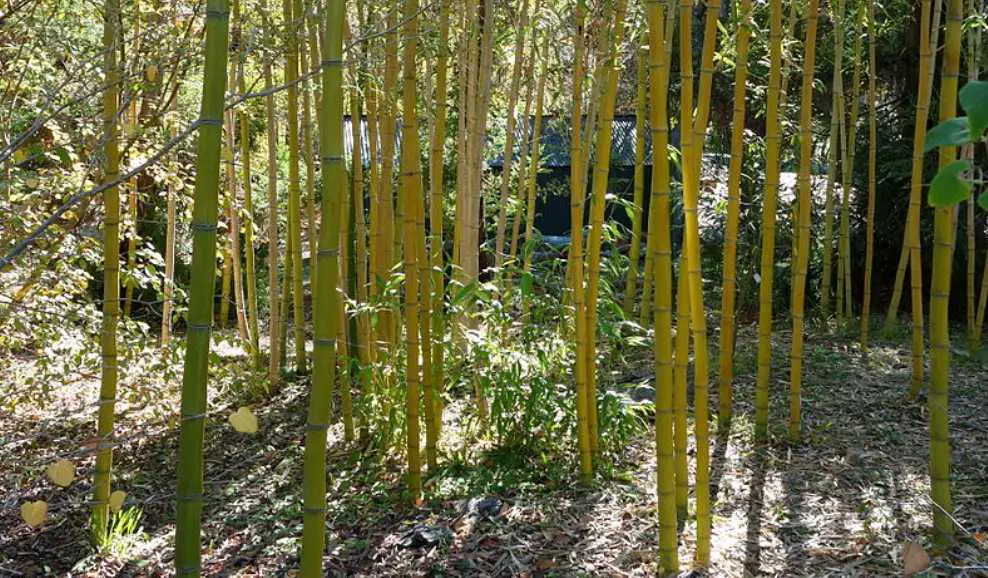
Phyllostachys vivax
You’ll definitely want to allow some extra space for this tremendous timber bamboo that easily reaches 40 to 50 feet in height, with culms up to 4 or 5 inches in diameter. As you can imagine, it will also have a pretty massive footprint. But for anyone who’s got the space for it, this majestic grass could be a prized specimen and the envy of bamboo enthusiasts all around.
I planted one of these in my suburban backyard in San Luis Obispo, and kept it in a 15-gallon pot for fear of it overtaking the neighborhood. After 5 or 6 years it never looked unhealthy, but it sure never reached the kind of stature described above. It really needs room to spread out.
As I said earlier, it can be a good idea to keep your running bamboo in a pot or container. But this is not the perfect solution. If you place the pot on the dirt, the roots will eventually crawl through the drain hole and get into the ground. Better to put the pots on a patio or a large stepping stone in the garden.
And if you do manage to contain your running bamboo, be aware, it will never reach full size. This is especially the case with a timber bamboo. In ideal conditions, the Vivax plant is a magnificent thing to behold. But in a pot, it will just sort of languish. So unless you have a great deal of space, there’s not much point in trying to grow a running timber bamboo in a pot.
For best results, plant your Vivax in the ground, but also surround it with a strong root barrier. Give it a wide berth, room to spread at least 8 to 10 feet in diameter. Then bury your root barrier nice and deep. And check up on it regularly. Left unchecked, a running timber bamboo can tear through most manmade boundaries.
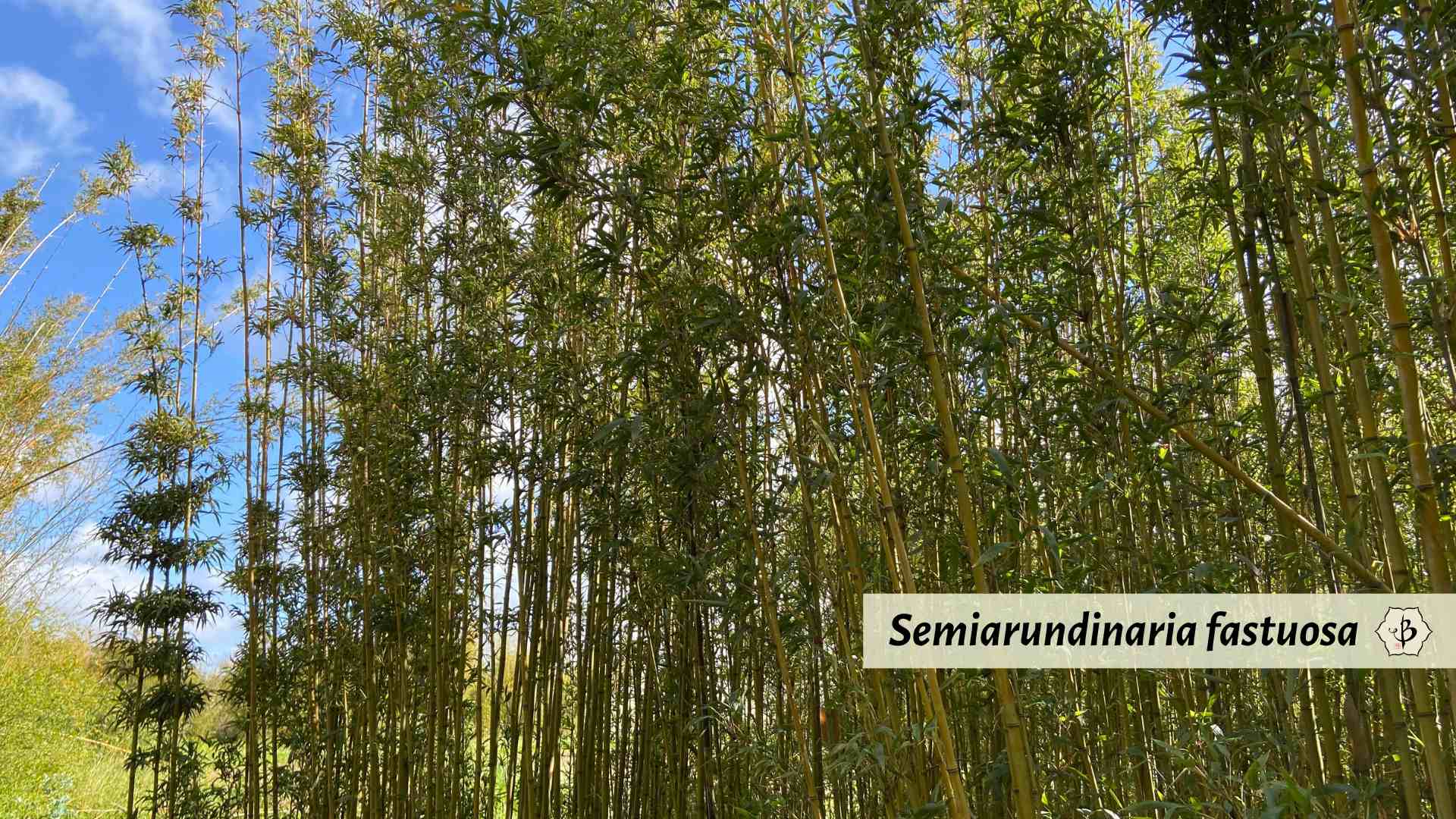
Semiarundinaria fastuosa (Temple Bamboo)
Another very impressive variety, its regal appearance has earned this one the nickname “Temple Bamboo.” It’s a catchy name, and also MUCH easier to pronounce. Temple Bamboo bamboo can get to be 20 or 30 feet in height, but its richly colored culms don’t grow much larger than an inch or so in diameter.
I also planted one of these in a 15-gallon container, but it didn’t take long to break out and proliferate around the yard. Even so, with such handsome shoots, I just couldn’t bring myself to uproot them. This really is a beautiful species of bamboo, with its long, straight, elegant canes.
Though my Temple Bamboo got into the ground, it never seemed to get really out of control. After 5 or 6 years, the plant was still only about 5 feet in diameter, and less than 10 feet tall. Perhaps if we lived somewhere warmer and rainier, it would have grown more aggressively.
Also, I rarely fed this plant anything more than an annual serving of compost from our own garden. We had very sandy soil conditions, not so rich in nutrients. But the advantage was in how easily I could dig into the sand and prune the roots. I would do this regularly, because people would often admire the beauty of this plant and ask for a cutting.
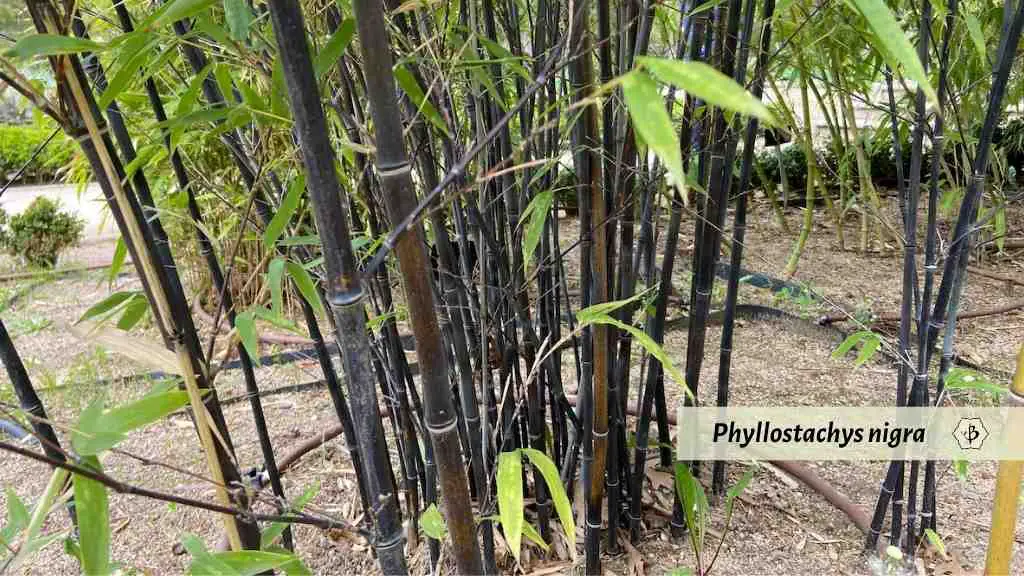
Phyllostachys nigra (Black Bamboo)
The distinctively dark brown (not quite black) canes make this one of the most popular strains of bamboo, and any nursery that sells bamboo is likely to have some of this on hand. As the plant matures, the dark color of the culms grows richer, making for a very attractive contrast against the bright green leaves.
Native to the Hunan Province of southern China, gardeners now cultivate black bamboo all over the world. Although it thrives best in its own subtropical habitat, it can grow very well in USDA zones 7-10. If planted in rich, loamy soil, black bamboo can get 20 to 30 feet tall with mature culms of 2″ in diameter.
A healthy specimen can easily act as the centerpiece in a garden, with its distinctly dark canes, and its billowing foliage. Once harvested and dried, black bamboo is also excellent to work with. The richly-colored poles lend themselves to any number of decorative uses, from fencing to furniture.
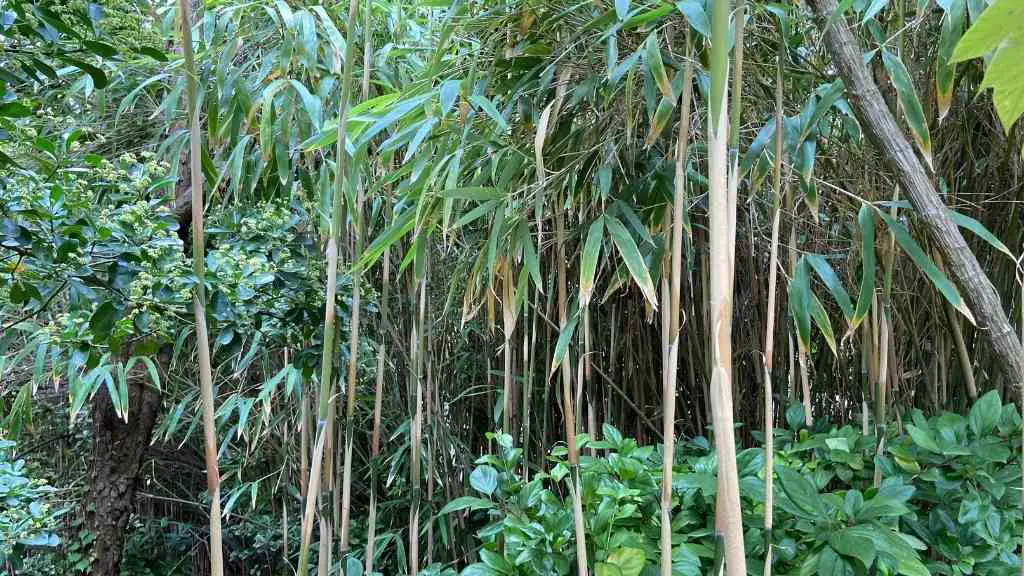
Pseudosasa japonica (Arrow Bamboo)
Also quite popular, arrow bamboo earned its name from its long, strong, straight poles, which Samurai warriors once used to make arrows. Today it’s a great choice for planting in shady corners of the garden. Also, though technically classified as a runner, it has a far more restrained growth habit than most bamboos of that class. And the broad green leaves make this a very vibrant and attractive specimen.
Arrow bamboo is an excellent candidate for privacy screens as it grows thick and dense. Its height, usually about 12 to 16 feet, makes it more manageable as well. An especially good choice for privacy hedges with height restrictions.
This variety does need to be well watered. If you’re in a dry climate like Southern California, arrow bamboo will not be your best choice. Try to keep it in a shady area that gets a lot of water runoff.
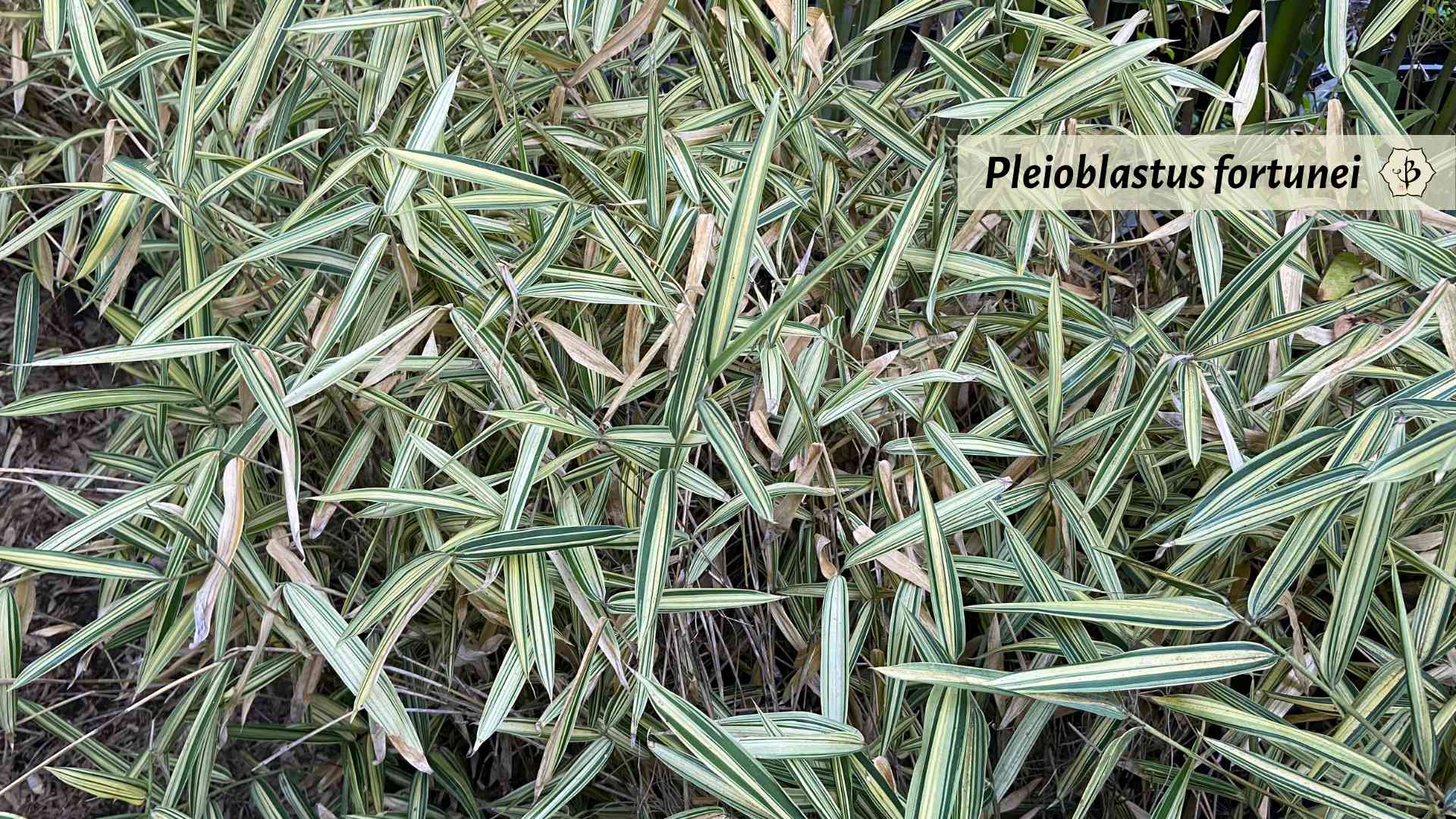
Dwarf Green Stripe
One of the few bamboos that can be cultivated as a ground cover, Pleioblastus variegatus (also called Pleioblastus fortunei) makes an excellent accent alongside larger bamboo varieties, around Japanese pines, and in any sort of Asian-themed garden setting. Its compact size also makes it much easier to contain, despite its being a runner. Just keep an eye on those roots!
Unlike most other striped varieties of bamboo, this one has stripes on its leaves rather than its canes. They are bright yellow with deep green variegation. The more sunlight it gets, the lighter the yellow becomes, turning almost white. The light green culms are barely as thick as a pencil and rarely grow more than 2 or 3 feet tall.
Dwarf green stripe is a fairly cold-hardy species, but it may look less vibrant during a frosty winter. Some gardeners will mow it back in the winter. When it comes back in the spring, it’s even thicker and more colorful than before.
CLUMPERS
While the most common ornamental varieties of bamboo tend to be runners, the conscientious gardener is always on the lookout for a good breed of clumping bamboo. The most impressive clumpers are native to the balmy tropics of Indonesia and Southeast Asia, but there are a handful of suitable species for cooler habitats, and certainly in mild climates like Florida and California.
Now before you rush over to Home Depot, or your nearest box store discount nursery, and start asking sales clerks for their recommendations on clumping bamboos, keep in mind that not many people — nursery employees included — can reliably distinguish a runner from a clumper. And as long as clumpers remain more expensive, more sought after, and harder to come by, it’s easy to imagine how unreliable certain salespeople could be.
With that in mind, I’d like to recommend a couple of my favorite bamboo nurseries in California: Bamboo Sourcery in Sebastopol and Bamboo Giant near Santa Cruz. These guys really know their bamboo. But if you want my opinion, here are a few of my favorite clumpers. Also check out our directory of North American Bamboo Nurseries.
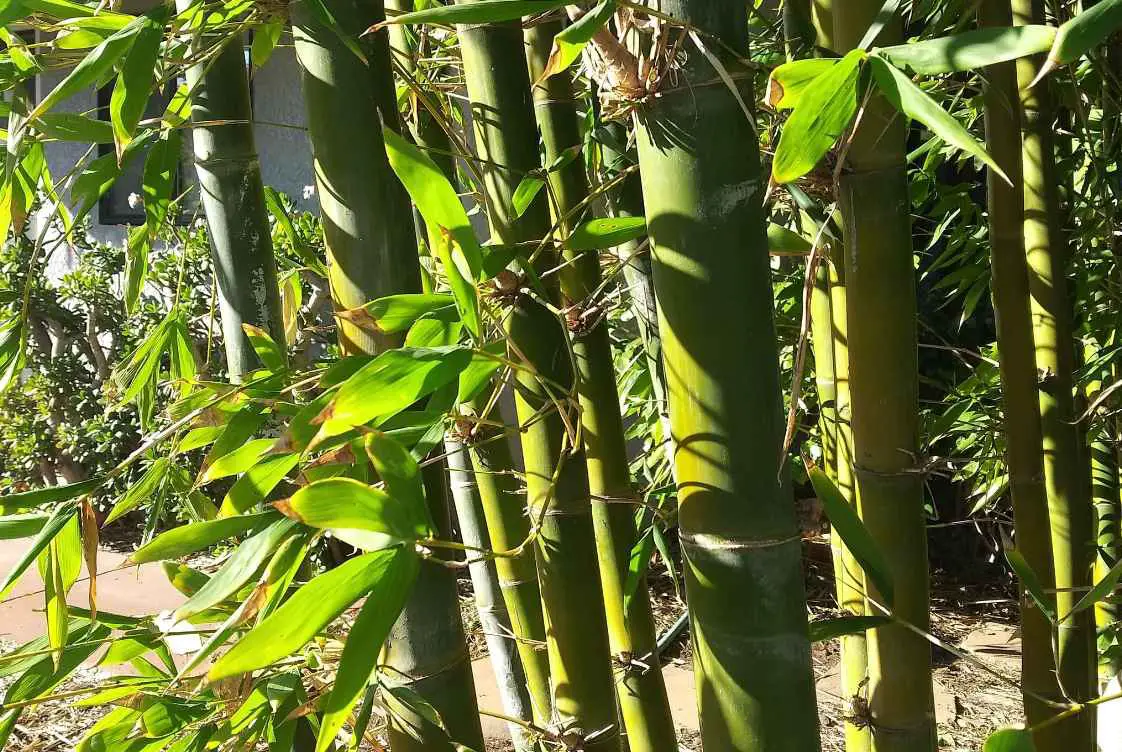
Bambusa oldhamii
An old favorite, Oldhamii is said to be the most widely grown variety of bamboo in all of the United States. You might say it’s an old standard. Native to Taiwan, it does have a preference for the tropical and subtropical climes, so it’s not very cold hardy. Only down to about 25º F. But with shoots reaching up to 60 feet or more (under ideal conditions) and growing up to about 4 inches in diameter, it’s certainly an impressive specimen, particularly for a clumper. You’d have to agree, it’s an oldie but a goodie!
Oldhamii is also a popular choice for a privacy hedge, with its bushy leaves and dense, upright canes. The thick poles make an excellent building material, too. And many bamboo enthusiasts will eat the sweet, young shoots of this variety. With so many uses, it’s hard to think of a reason NOT to plant a grove of Oldhamii.

Otatea acuminata (Mexican Weeping Bamboo)
With its slender stalks and delicate, wispy leaves, this delightfully compact specimen looks good in nearly any garden. All it needs is a gentle breeze to make it really come alive. It also prefers warmer climates. But I grew some in a cool, coastal climate, and it always looked happy.
A versatile species, this bamboo does well in a variety of conditions. Near the ocean, it’s not bothered by the salty sea spray. In California, it can tolerate the dryness. It’s native to Northern Mexico, after all. But it’s also cold hardy down to about 20º F. And in small gardens, the weeping bamboo does quite well in a pot.
The thin poles grow up to 10 or 15 feet tall, but the gracefully cascading leaves are what give the plant its unique appeal.
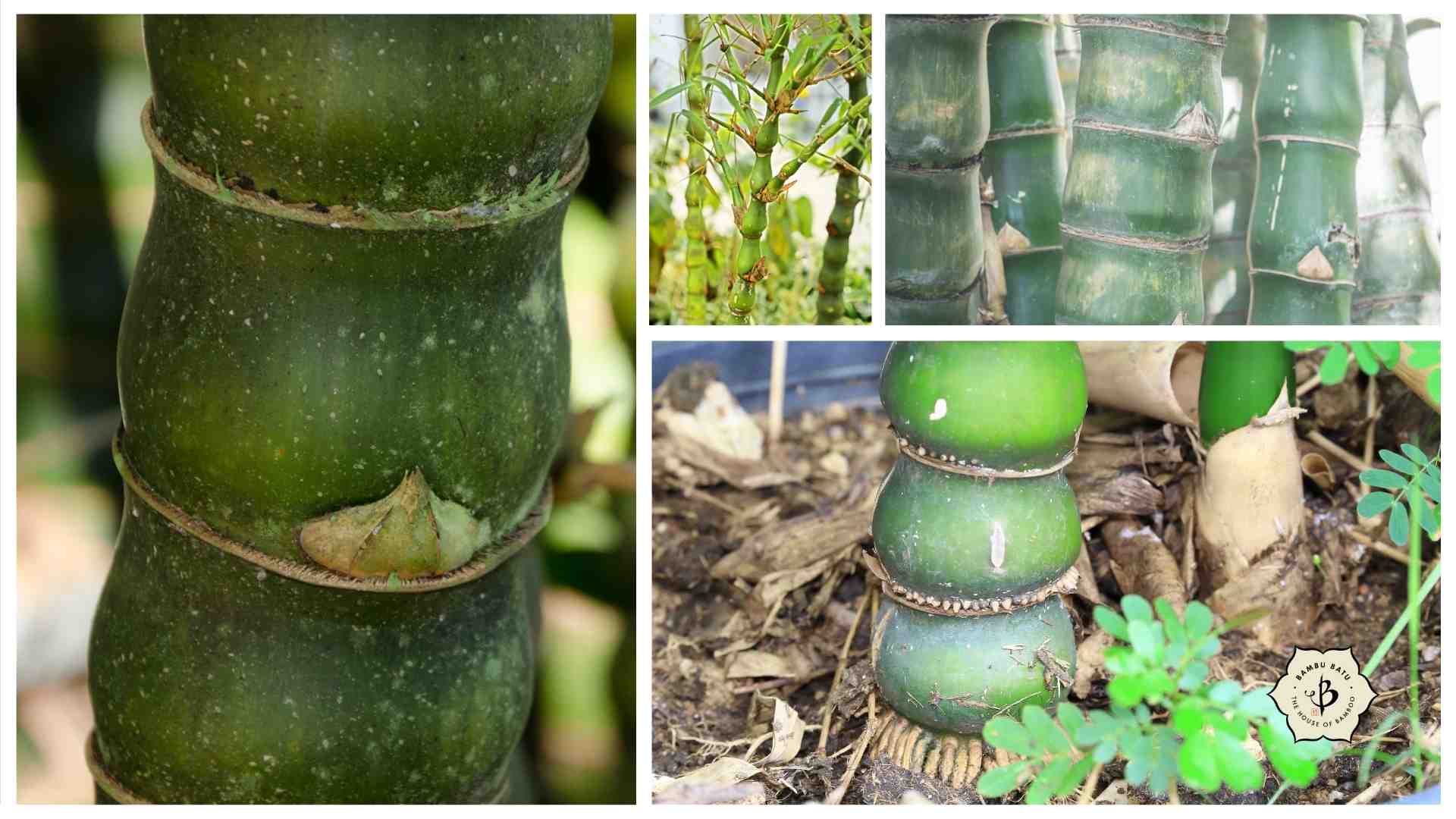
Buddha’s Belly (Bambusa ventricosa)
With a catchy name derived from the bulbous shape of its internodes, Buddha’s Belly is one of the easiest species to recognize and one of the larger varieties of ornamental clumping bamboo. Some poles also grow in zigzags instead of upright. But whatever it lacks in straight and narrow poise, it more than makes up for with portly character. This subtropical marvel also does better in the warmer zones.
The most common variety of Buddha Belly is the Bambusa ventricosa, which gets about 30 feet tall with 2 to 3 inch culms. Giant Buddha Belly can grow up to 45 feet tall, with the entire clump spreading to about 15 feet in width. Perhaps the most beautiful variety is the Yellow Buddha Belly Bamboo (Bambusa ventricosa kimmei) which puts up green shoots that gradually turn yellow and take on a lovely striped effect.
There’s also a dwarf variety that stays shorter and more compact, Bambusa vulgaris ‘Wamin’. This one is especially suitable for bonsai purposes.
To encourage the culms to bulge out and make the distinctive Buddha Belly shape more pronounced, gardeners have a few tricks. It’s important to prune the bamboo at least once a year. By preventing the plant from growing upward, it will tend to grow more outward and zigzagged. Also, a little water deprivation can cause just enough stress to make more bulbous culms. If too many of your culms are not looking belly-like, try watering it once a week instead of twice a week, or maybe even less.
See our in-depth article on Buddha Belly Bamboo for more details.

Alphonse Karr
Exquisitely elegant, Bambusa multiplex ‘Alphonse Karr’ is easy to recognize with its green and yellow racing stripes. Even amidst a great collection of bamboos, this one is sure to stand out. In ideal conditions, it can get up to 20 feet, and the culms grow to about 1 inch in diameter.
Although slower growing, Alphonse Karr is a popular choice for hedging because of its attractive poles. To accentuate the colorful stripes, try pruning back all the leaves from the bottom 3 feet or so of the plant.
Native to the tropics and subtropics of Asia, Alphonse is much happier in warm climates. Avoid planting it in USDA zones below 7 or 8.
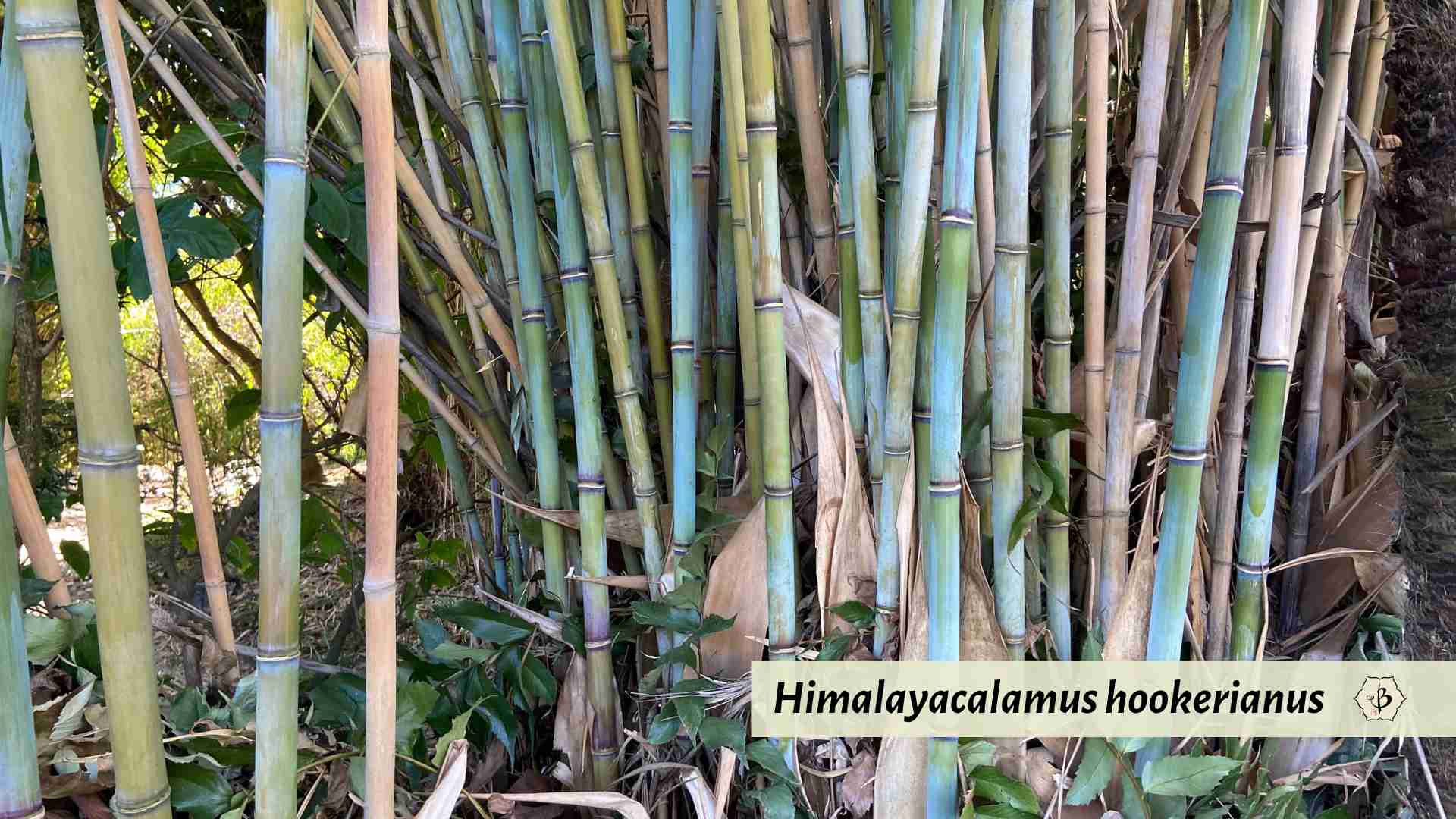
Himalayacalamus hookerianus (Himalayan Blue)
The wonderfully colored, powdery blue culms give this bamboo an especially attractive appearance. Indigenous to the mountains and foothills of southern China, it does better in a cool climate than most other clumpers. In fact, it has a hard time in a hot, humid region like the Deep South. But it grows especially well around ponds and in containers. Culinary tip: fresh shoots of the Himalayan Blue are edible and are said to be quite tasty. Anyone for stir fry?
Conclusions
Before you decide which bamboo to plant in your garden, you’ll need to consider how much space you have and what you are trying to achieve. Do you want something compact and decorative? Or are you looking for something that will spread quickly and provide a lot of privacy? Or maybe you’re growing bamboo for the canes, and you have a construction project in mind.
Check out our article on How to Choose the Best Bamboo, to get a better idea of what factors to think about and which species will be most suitable for your setting.
Based on your needs, you can select a runner or a clumping variety, something short or something tall. And then plant it in the appropriate spot in your garden. Or, better yet, choose a few different varieties of bamboo, and create a beautiful space that brings many pleasing and complementary characteristics together.
And once you’ve finished selecting and planting your bamboo varieties, you might consider adding a bamboo fountain somewhere for an added sense of zen. Then it’s just a matter of sitting quietly and waiting for the breeze to come through, rustling the leaves and knocking the canes.
I hope you’ve found these suggestions helpful. If you have a favorite bamboo that we were unable to include in this short list, go ahead and let us know in the comments section. Meanwhile, happy gardening!
Also, be sure to take a look at some of our other useful and stimulating articles.
- Growing bamboo: The complete how-to guide
- The Bamboo Species Guide
- 12 Cold-hardy bamboo varieties
- Best bamboo for hedges and screens
- Growing bamboo in the shade
- Timber bamboo: Greatest of grasses
- Drought-tolerant bamboo for dry climates
- The best bamboo varieties for construction
NOTE: This article originally appeared in December 2018, last updated in February 2024.
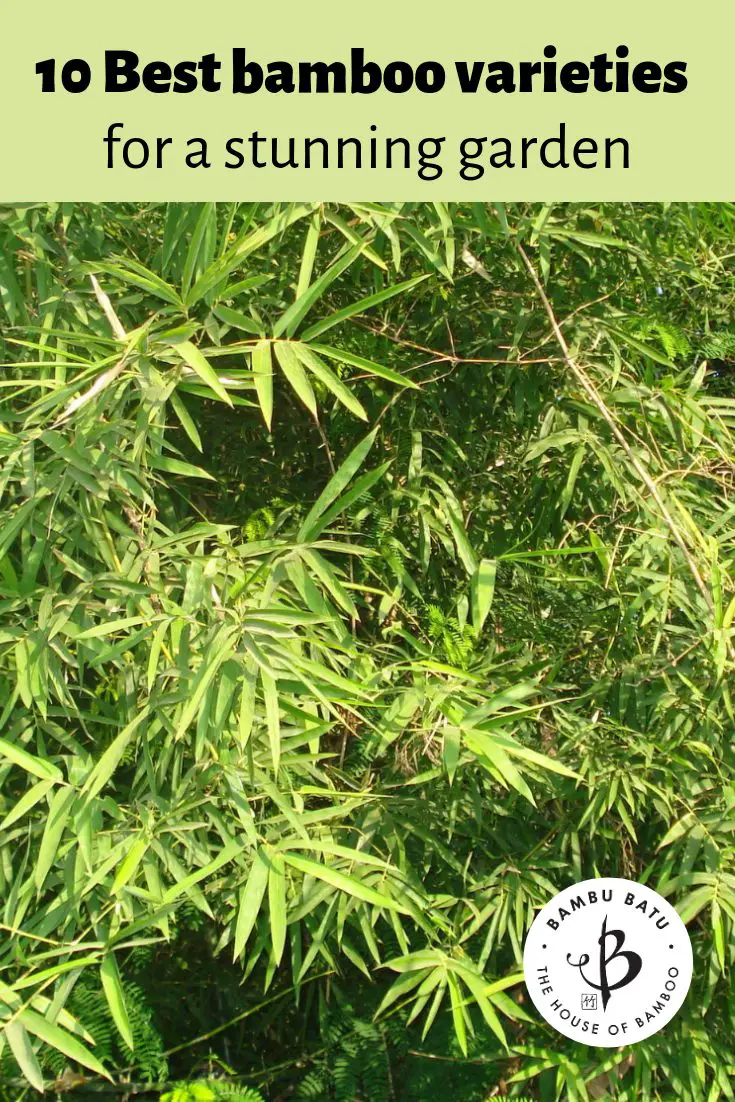


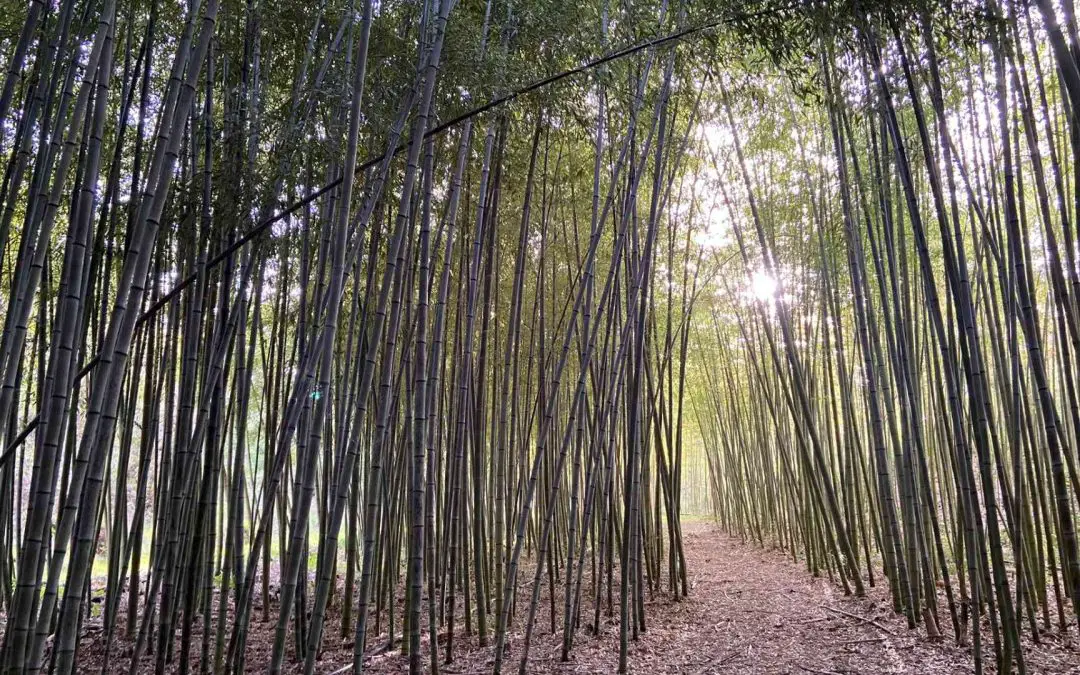
























Very informative well written would have been just a superb write out if you have given a photograph of each variety for us to identify and understand Anyway good piece of text about bamboo 👍
Thanks for the feedback. I just updated all the photos!